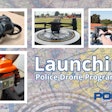There are a lot of inventors, entrepreneurs, and defense contractors worldwide who have developed tactical equipment in the last few years. Wars in Afghanistan and Iraq, the worldwide threat of terrorism, and the body counts racked up by active shooters have fueled the market for such products and spurred innovative people and companies to produce a wide variety of high-tech equipment and gear with the hopes of selling it to the military and to law enforcement.
Much of this stuff is really expensive and more applicable to war fighting than police work. But some of it is just what SWAT teams want...If they can find a way to pay for it.
So what kinds of new "toys" are police tactical teams using on the job? The answers are both predictably high-tech and surprisingly low-tech.
Things are not technologically stagnant in the SWAT community. With some 50,000 SWAT deployments each year, the SWAT community can't afford to rest on its laurels. New versions of the tried and true, as well as innovative uses of modern mechanisms, simultaneously bring SWAT teams closer to suspects in the safest way possible and bring situations to safer conclusions. These tools are the outgrowth of the innovative synergy created among SWAT reformers, clever budgeters, and yes, better mousetrap builders.
In some instances, innovation has meant simply taking existing tools and modifying them to a unit's needs.
Mechanized Entry
The San Bernardino (Calif.) Sheriff's Office did just that with its "tank."
The SBSO's "tank" is actually a Caterpillar skip steer loader that has been retrofitted with armor capable of defeating .50 caliber rounds. It's also essentially a new twist on a battering ram that allows officers to breach into numerous types of structures. And as is so important in contemporary law enforcement operations, the tank doesn't just tear holes in buildings for SWAT to enter, it videos the entire operation.
Lt. Nils Bentsen believes SBSO's tank was the first such tool deployed in the SWAT community, although a few other teams have since adopted the tractor because of all the things it can do.
"In many barricade situations, suspects have the advantage by knowing where doors, windows, and walls are and exploiting them," Bentsen says. "By systematically eliminating such portals, the tank puts the SWAT officers on equal footing."
Upon gaining entry to a location via its decidedly low-tech tank, the SWAT team can use a variety of high-tech less-lethal weaponry to neutralize threats. One of the most effective tools in the team's arsenal has proven to be the Extended Range Electronic Projectile (XREP)-a wireless TASER launched from a 12-gauge shotgun platform.
Bentsen acknowledges that the tank has garnered controversy because of the amount of structural damage it is capable of inflicting. But he also is quick to counter that concern.
"When all is said and done, I believe that any repair costs are more than offset by the money that would be spent cleaning up the aftermath of flash-bangs and other contaminating agents otherwise deployed," Bentsen says.
If that isn't enough to knock the fence-straddlers from their perch, consider this: No suspect or officer has been lost incident to the tank's deployment.
Beyond that, use of the tank has enabled the SBSO SWAT unit to cut operation times from an average eight-hour standoff to three or four hours without cutting corners or sacrificing officer or civilian safety.[PAGEBREAK]
Robocops
One area where innovation is finding inroads in SWAT deployment is robotics—both in their acquisition and deployment.
"The L.A. style of barricade handling has historically been one of slowing things down and clearing things room by room," notes Sgt. Scott Gillis with the Boston SWAT Unit. "But robots have greatly enhanced our officer safety. Not only can they identify where a suspect is located inside a location, but they can transmit audio from the room. We can hear when he coughs. If his speech is slurred, we can tell the degree of his intoxication."
Perhaps no other tool in the contemporary SWAT arsenal has more potential to prevent police and suspect casualties than robots. Gillis explains that robots give SWAT both valuable real-time intelligence and the ability to engage the suspect without endangering officers.
"If there's a lone gunman in a house, there's no reason for us to go in there," Gillis says. "We're not cowboys—we're risk mitigators. The suspect has the ability to lie in wait and have the advantage. In terms of cutting edge stuff, I think robots are something that SWAT can and should increasingly rely on."
Not only can robots relay information regarding barricaded suspects, they can provide incident commanders with a lay of the land.
"The robots utilized have both audio and visual capabilities," observes Gillis. "Based upon what the robot can bring up on a screen, you can develop a plan of entry. It can tell you once that front door opens what you'll see next: There's a long hallway with rooms both left and right and it ends up at a kitchen. We can develop a room-clearing plan based on that. Or if the door opens into a living room and there's a stairwell that leads to a basement when you thought the only access to the basement was from outside. You can make sure that you have sufficient manpower for all of the escape routes."
Sgt. Chito Walker is a supervisor with Charleston, S.C., SWAT. He, too, notes the robots have been a huge asset in tactical law enforcement operations. "We work hand-in-hand with our explosive device team. We try to use our robots as much as possible before we commit to making entries ourselves," he says.
"A prime example is an incident we handled two months ago wherein a suspect fired several rounds at his girlfriend before barricading himself. After initially contacting the suspect and then losing contact with him, we breached the location and put the robot inside. The robot was able to find the suspect in the bedroom and give verbal commands for the suspect to prone himself out. The suspect complied and we were able to go in and detain him without any further incident," Walker says.
In the past such an incident would have ended very differently, according to Walker. "When I first came in, we were doing everything almost barbaric style.... It was all dynamic entries, all the time."
Robots have gone beyond the front door and out the back, and proven their value in enclosed yards, as well.
When 45-year-old man twice fired off his shotgun before barricading himself in his backyard, the Lodi, Calif., SWAT team deployed its own robot.
Remotely controlling the 400-pound robot, officers knocked down a portion of a fence to gain entry into the backyard. Once inside the perimeter, the robot's infrared sensors located the gunman lying down in the yard. Shortly thereafter, a K-9 was able to take the man into custody, ending a four-hour standoff.
Lodi SWAT commander Chris Piombo reported on Recordnet.com that the robot ensured the safety of everyone involved.
"I didn't want to put anybody in that backyard," Piombo said. "He said he wasn't going to be taken alive, and it was pitch black. The robot could see like it was daytime."
Incident to the gunman's arrest, Lodi police found two handguns concealed in the backyard and three high-powered rifles with sighting scopes in the house along with approximately 500 rounds of ammunition.
Creativity has likewise figured prominently in the acquisition of robotics. Some SWAT teams have even approached local high schools to help develop robotic technology. Students such as those at West Covina High School in California and East Lake High School in Florida readily accepted challenges by law enforcement agencies to help fund and design functional robots with SWAT abilities.[PAGEBREAK]
Into The Breach
Of course, not all tactical entries can be made via a robot or armored vehicle. Elevated landings, interior hallways, and other architectural barriers will continue to obligate live entries. Many SWAT officers felled in the line of duty were shot while making such entries.
A tragic 1999 incident in Cobb County, Ga., is an example of what can go wrong during a dynamic entry and how much SWAT depends on quality intel. While one entry team was able to breach a basement door without a hitch, another had difficulty getting through a kitchen door. The first blow from their ram had very little effect, and the second only knocked out a panel. After a flash-bang was tossed through the open panel to stun the suspect, the team hit the door again with the ram, this time with success. Three members of the five-man team poured into the doorway and into a cramped and darkened kitchen where they were immediately fired upon by a man inside. Two officers from the Cobb County Police Department's SWAT team were killed.
Getting through these portals of death without using armored vehicles often comes down to one of four types of entry tools: mechanical, thermal, ballistic, and explosive.
BlackHawk's ThunderBolt entry ram is ideal for pulverizing a dead bolt right out of the jam of most residential or even commercial doors. But when faced with multiple locks and bars, SWAT teams will often opt for some non-mechanical means.
When it comes to breaching locations, some agencies face tougher structural obstacles than others.
"Charleston is a very unique and very historical town," observes Sgt. Walker. "We have a lot of colonial style houses so we don't encounter a lot of windows with burglar bars or doors that are stacked up behind one another. Because of that we tend to rely on the ram. On those locations where we do encounter steel on steel situations, we rely on the hydraulic ram."
Cpl. Todd Stratman of the Dallas SWAT unit notes that his team deals with tougher architecture. "We're continually coming up against houses that have burglar bars on the windows and doors. We do a lot of ballistic breaching."
Stratman believes there is room for improvement when it comes to explosive breaches. "It'd be nice if someone would come up with something that accomplishes the same kind of breach explosives do, but with less of a charge," he says.
Explosive breaching can be dangerous to both the breachers and the room occupants. So some agencies are hesitant to allow tactical officers to use such techniques. Charleston's Walker is cautiously optimistic: "Our chief is looking seriously at using more ballistic and explosive breaches, but that hasn't happened yet."
In the meantime, non-federal law enforcement will most likely continue to favor the less damaging ballistic breach. Used to destroy latches and locks or door hinges, the ideal choice launcher is the shotgun, as it is simultaneously more effective than handguns or rifles at close distances and carries less risk of ricochets. Frangible rounds turn to dust after knocking out the hinges, and disperse completely.
Picture Perfect
SWAT teams have been recording their deployments to justify their actions in criminal and civil proceedings for years now. But today's technology lets the camera lens protect them in the field, as well.
Sgt. Brian Winter of Visalia, Calif., SWAT notes that a variety of cameras are increasingly finding a role in tactical law enforcement operations.
"Agencies are increasingly using pole cameras to help with surveillance," Winter says. "Whereas in the past we had to use an officer to look inside crawlspaces and attics, we can get visuals on them through the use of pole cameras, which makes the job much safer. We even have thermal imaging on our Bearcat, which helps as well."
SWAT operations will always involve an element of danger. But as the tactics and the tools of the profession change so will the numbers of injuries and deaths to both officers and civilians.


















